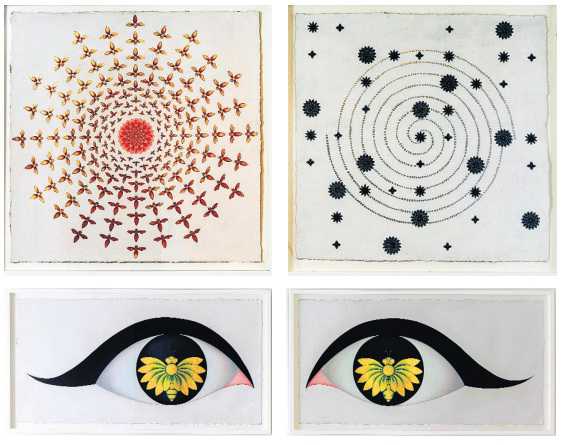
Monica Arora
An ode to Indian philosophy, the practice of yogic and tantrik techniques, meditation, indigenous dyes, material, as well as miniature painting, artist Olivia Fraser’s show, Amrit, is soothing, reflective, introspective as well as aesthetic. The deployment of plant and mineral pigments on handmade paper further extends the narrative thread which runs between these immensely powerful visual representations. The exhibition coincides with the release of her new book, A Journey Within, which is an extension of the theme of the artworks.
Excerpts from an interview:
How has India influenced your personality?
I’ve spent most of my adult life either in India or being completely influenced by what I do by India. So, in a way, India has totally transformed me. I initially came here as a young student visitor back in 1989 and looked at the country from an outsider’s perspective — initially painting the people I encountered or the places I visited. I used Western watercolour techniques and Western materials. Slowly, I became entranced by Indian miniature painting and started making my own versions, particularly influenced by the 19th-century Company School paintings, where Indian and European painting traditions seemed to fuse so beautifully. Then, in 2005, we brought our young family back to live in Delhi and it was then that I decided to dive properly into the language and philosophy of traditional Indian miniature painting. I discovered that learning this art form required a completely different outlook. It should all come from within. There was only one way to paint a banana leaf and that knowledge should be there. Learning it was like learning a language — a language of colour, space, shape, line and rhythm.
What according to you is Amrit, the nectar of immortality, as described in Indian mythology? How has this interpretation manifested in this exhibition by the same name?
I’ve called the exhibition Amrit as I was thinking about the immortal nectar — the nectar of the gods granting immortality — and its possible association with reaching for a similar goal as yoga. Over the last few years and particularly in this show, my artistic inspiration has been increasingly bound up with visualisations in yoga, particularly as witnessed in my own practice and as described in texts like the 18th-century Sanskrit yogic manual called the Gheranda Samita. There is a wonderful extract which I love: “The yogi should visualise a sublime ocean of nectar in his heart, with an island of jewels in its middle whose sand is made of gemstones. In every direction, there are kadamba trees with abundant flowers and it is ringed with a thick kadamba forest like a stockade, where the scents of malati, mallika, jati, kaisara, champa, parijata and sthalapadma flowers perfume every quarter. In its middle, the yogi should imagine an enchanting wish-fulfilling tree whose four branches are the four Vedas and which permanently bears flowers and fruit. Bees and cuckoos buzz and call there...”
I’ve used the icon of the lotus and that of the bee (which is something I’ve created, inspired by the plethora of poetry about it, using it as a metaphor for desire) representing something passive and something active — the bee in search of the nectar within the lotus. I want to explore the idea of visual roadmaps for meditation.
You have deployed indigenous mineral and plant pigments on special handmade paper for all the paintings. Has the conversation around conservation of natural resources and environmental concerns prompted this?
I was thrilled when I discovered that this knowledge of using traditional, handmade materials all sourced locally and in their natural forms in the markets in Jaipur still existed. As Jaipur is the centre of the gem industry in India, there are always lots of off-cuts of semi-precious stones, as well as many other natural pigments that are used by many different professions: by artists but also by jewelry-makers, for homeopathy and for puja. So there is still a thriving market for these materials, but the ease with which plastic paint and plastic/throw-away art materials sourced from across the globe can now be bought cheaply here has dented the art of miniature painting. So, I’ve been particularly aware that conserving this traditional knowledge is of utmost importance, and using materials locally sourced is hugely critical to this. It is also a matter of wonder — the wonder of the transformation you can witness as you use sap from a tree over there, or a chalk white from the hills nearby for your artwork. It’s a question of connection too — thinking right back to those early cave painters who seem to connect and communicate across the millennia to us today through using their discovery of red earth pigments and being able to make handprints on cave walls...
The lotus and the bee, two extremely potent yogic and tantrik symbols, appear in several of your works…
There is so much poetry and symbolism attached to bees and lotuses. They are frequently associated, for example, with Krishna or the gopis, like in this couplet by the blind devotional poet Surdas: “At the sight of Hari’s face, my eyes lose their way: They’re love-struck bees who are mired in the mud beneath a charming lotus, powerless to fly.” And then there are yogic asanas particularly centred around with the lotus or the bee... for example, the Bhramari asana, which is described beautifully in this extract from the Gheranda Samita: “Slowly draw in air and perform Bhramarikumbhaka. Exhale it very slowly and then the sound of a bee will arise. On hearing the sound of a bee from within, lead the mind there. Samadhi will occur, together with the bliss arising from the realisation, ‘I am that’.” My practice and poetry inspired the indigo and gold leaf triptych Bhramari that I made for this show... with the ever-denser deconstructions of bees/petals/wings possibly reflecting an increasing sense of sound or oneness of the bee with the lotus.


























